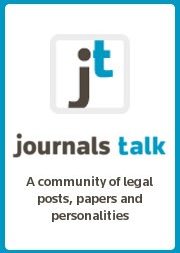Journal of Law and Medicine update: Vol 30 Pt 3
By journalalerts on March 21, 2024
Posted In: Journal of Law and Medicine (JLM) Tagged: "Life at the Frontiers of Biomedicine: Creating "Missing Persons": Absent voices of people with dementia in the Australain Royal Commission into Aged Care ACP Adel Rahmani admissibility of evidence advance care planning Advanced Personal Planning aged care aged care system AI Alexandra Stratigos Amy Waller Anthea Vogl APP Article Artificial Intelligence in Medicine: Issues when determining negligence assessing evidence Australian Consumer Law Australian Health Practitioner Regulation National Law Australian law BBVs Ben P White benefitting humanity Benjamin Riley Bernadette McSherry Bernadette Richards Biological Weapons Convention blood-borne viruses book review Briony Johnston Cameron Stewart Carolyn Johnston Casey M Haining Charles Lawson Chris Corns Civil Liability Act 2002 (NSW) coercive questioning commissions of inquiry Comparing VAD laws in Victoria and WA: WA stakeholders' perspectives Consumer or Patients? Medical Device Recipients under Australian Law Straddle Two Worlds Crimes (Biological Weapons) Act 1976 (Cth) criminal prosecutions David J Carter deaths in custody decision-making dementia care detainees discipliary proceedings Dr Rita Matulionyte dua use research duty of care and causation Editorial educaiton employers end of life Enhancing and Extending Human Life" entry onto private property ethical concerns family and care partners Freedom of Information Gain of Function and Loss of Control gathering evidence Gene Techology Act 2000 (Cth) Genetic modification of microbial agents Gill v Ethicon Sarl global public health pandemic responses Hamish Roberston health law reporter health matteres Health Practitioner Regulation National Law Act 2009 (Qld) Hui Yun Chan Ian Freckelton AO KC integration intellectual property interdisciplinary collaboration Interdisciplinary Collaboration in the Mental Health Sector: Legislating the Vic Colaborative Centre for Mental Health and Wellbeing Investigating Investigation Powers under the Health Practitioner Regulation National Law Is IP the COVID-19 bad guy? Lessons we could learn from the pandemic James J Brown Jane Nielsen Joanne Travaglia Julia Symons jurisdiction Kay Wilson Key Informant Persepctives on Berrier to Advance Personal Planning: Results form a Quallitative Interiew Study Kozarov v Victoria Kristina Chelberg and Kate Swaffer legal and financial matters legal difficulties Legal issues legal liability legal solutions Lessons from Re Teo: Unconventional Practice and National Law Lindy Willmott Marco Rizzi Margaret Otlowski mark J Cowley marketing approval medical device recipients medical issues medical malpractice medical products mental health mental health consumers mental health issues mental health sector Mike O'Connor National Health Security Act 2007 (Cth) needs and interests Nola M Ries novel medical technology NVivo occupational health and safety older adults OPP patient preferences patients and consumers patients and families Paul Nolan personal personal protective equipment police officers practical and legal barriers practitioners predictive modelling privacy produce harm public health Public Mental Health Framework raw genomic data RCAC Re Teo [2023] NSWMPSC 2 Rebekah McWhirter regulation research participant rights resistant to vaccines restraint Rhys Evans Royal Commission into Aged Care Quality and Safety SD Pattinson sexual health sexual violence sexually transmissible infections Speciailist Sex Offences Unit Spit hoods stakeholder groups statutory protections STIs testing and treatment the individual The Legal Needs of People Lyving with a sexually transmissible infection or blood boarne virus: perspectives from a sample of the Australian Sexual Health and Blood Borne Virus workforce They can have our cake - but can we eat it? Access to raw genomic data under Australian privacy law tort of negigence traditional clinical practice transmissible TRIPS unmet legal needs vaccine VAD Vic Vicarious Trauma and Public Mental Health Framework: Kozarov v Victoria [2022] HCA 12 and its aftermath Victoria viruses 'on steroids' voluntary assistend dying WA waiver Westeran Australia When will death be? Legal Considerations and Regulatory Safeguards in predictive modelling applicaitons for end-of-life care Work stress WTO

